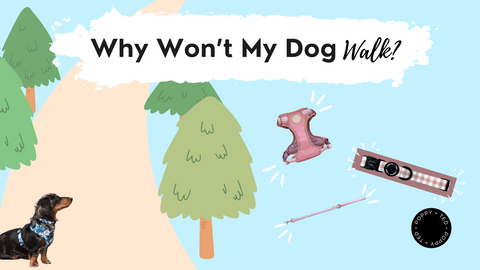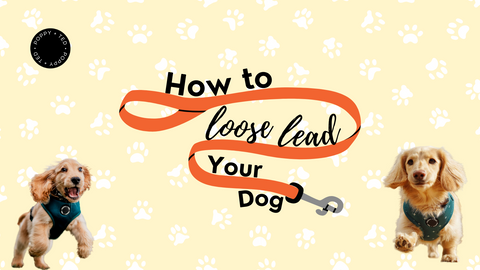Any dog owner will tell you that the excitement of a walk for their pup is filled with wagging tails and dashes to the front door. In fact, in some cases, the very word walk needs to be spelt out to avoid puppy dog eyes and whining. But for others, it can be a challenge and a source of frustration for a dog who refuses to walk or gives up mid-walk. In this blog, we will explore some of the reasons behind this behaviour and offer valuable tips and advice to help you and your canine companion enjoy stress-free walks together.
Understand the Source of the Problem
Before we delve into the solutions, it's crucial to pinpoint the exact reason behind your dog's reluctance to walk. Dogs communicate through their behaviour, so observing them closely can provide valuable insights into their feelings. Here are some in-depth explanations for common reasons behind your pup's hesitation:
Fear or Anxiety:
Just like humans, dogs can experience fear and anxiety. The world outside can be overwhelming, with unfamiliar noises, people, and other dogs. Sometimes, a traumatic event or negative experience during a walk can lead to fear. Signs of fear or anxiety may include trembling, tucking the tail, avoiding eye contact, or cowering.
Solution: To help your dog overcome fear or anxiety, start by creating positive associations with the leash and outdoor environment. Begin with short walks in familiar, low-stress areas, gradually exposing them to new sights and sounds. Reward calm behaviour with treats and praise. Additionally, consider desensitisation training, where you expose your dog to gradually increasing levels of the stimulus, causing fear and helping them become more comfortable over time.
Physical Discomfort:
Dogs may avoid walking if they're experiencing any pain or discomfort. It could be as simple as a thorn in their paw, an ingrown nail, or more severe issues like joint problems or muscle soreness.
Solution: Regularly inspect your dog's paws, legs, and body for any signs of injury or discomfort. If you notice anything unusual, consult your veterinarian for a thorough examination. Addressing any physical issues promptly can make a world of difference in your dog's willingness to walk.
Lack of Training:
Sometimes, dogs haven't been properly trained to walk on a leash or haven't been exposed to the walking experience. Without guidance, they might not understand what's expected of them.
Solution: Leash training is essential for every dog. Start indoors or in your backyard, where there are fewer distractions. Use treats and positive reinforcement to reward your dog for walking beside you without pulling. Gradually increase the difficulty by walking in different environments, like a quiet park or your neighbourhood. Consistency and patience are key here, and enrolling in obedience classes can also be beneficial.
Why Does My Dog Stop Mid-Walk?
In addition to the initial reluctance to start walking, some dogs may exhibit peculiar behaviour, stopping mid-walk. This can be perplexing for dog owners, but it often indicates specific concerns or needs that your furry friend wants you to address. Here are some common reasons why a dog might stop in its tracks during a walk:
Fatigue:
Dogs, like humans, can get tired. If your dog is not accustomed to long walks or physical activity, they might pause to catch their breath or rest their paws.
Solution: Pay attention to your dog's energy levels and physical condition. If your pup appears exhausted, consider shorter walks, frequent breaks, or reducing the intensity of your exercise routine. Always carry water to keep your dog hydrated.
Anxiety or Fear:
Your dog might stop if they encounter something that makes them anxious or fearful, such as a loud noise, a sudden movement, or an unfamiliar animal.
Solution: If your dog suddenly stops and appears anxious, try to identify the source of their fear. Comfort them and give reassuring pets and treats. Gradually introduce them to these situations in a controlled manner to help them overcome their fears.
Distractions:
Dogs have keen senses of smell, and they can be easily distracted by interesting scents along the way. They might stop to investigate a particular smell or object.
Solution: Be patient when your dog stops to explore. Allow them to indulge their curiosity to some extent, but gently encourage them to continue walking after a reasonable time. You can use treats or a favourite toy as motivation.
Physical Discomfort:
Just as physical discomfort can prevent a dog from starting a walk, it can also cause them to stop mid-walk. This discomfort may arise from issues like paw irritation, a pebble in their shoe, or sore muscles.
Solution: Check your dog's paws and body for any signs of discomfort. If you notice anything, address it promptly. Carry a first-aid kit on your walks to deal with minor issues like a small cut or splinter.
Heat or Cold:
Extreme weather conditions can be uncomfortable for your dog. They might pause to seek relief from the heat or cold.
Solution: Dress your dog appropriately for the weather, and be mindful of their comfort. In hot weather, take breaks in the shade and provide water. In cold weather, ensure your dog is adequately bundled up and protected from icy conditions.
Embark on a Happy Walking Journey with Poppy + Ted
Walking your dog should be an enjoyable experience for both you and your four-legged companion. By understanding the reasons behind your dog's reluctance and following these tips and advice, you can work together to build a positive association with walks and strengthen your bond. And don't forget to explore our selection of comfortable harnesses, collars, and leads to ensure your dog's comfort and safety on every adventure.
Happy walking!



